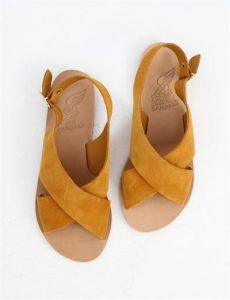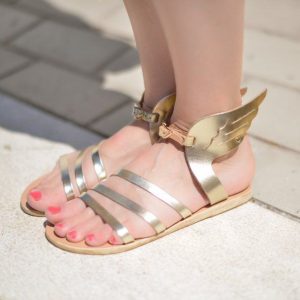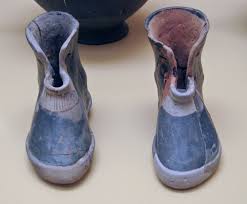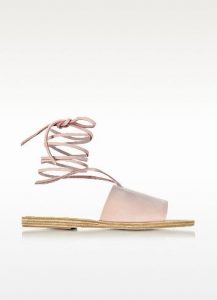Footwear was something that never bothered the Ancient Greek people. They did not consider them as part of their fashion and never really used them. They preferred to walk barefoot. Also in winter months and in cold conditions, they preferred to walk barefoot. It was only in cases of extreme conditions that they wore leather sandals or boots. That was also a very very rare occasion. It must be mentioned that the Ancient Greek people perceived the footwear, particularly the shoes, of their period as unaesthetic, unnecessary, and self-indulgent which was for all practical purposes, not much of use for them.

Men’s Footwear: The Ancient Greek Shoes
For the men in Ancient Greece, shoes were the main form of their footwear. They were primarily worn by them in the theatre, which was a way of increasing stature. Normally, in those days, common men went to the theatre also, barefoot. So shoes, which were mostly made of leather, were unaffordable for the masses, only the financial elites could think of acquiring them. Even the athletes who participated in the Olympic Games, also played barefoot, in fact, some of them played without any apparel as well. Thus they came completely naked. In the Ancient Greek mythological narratives, as well, the Heroes, Gods, and Goddesses were mostly depicted barefoot. Such was the strong belief of the Ancient Greeks against wearing any kind of footwear. On the battlefield also, the hoplites’ fought without any footwear. The legendary warrior, Alexander the Great of Macedon, conquered half of the world with his barefoot armies. So we can say that the use of shoes was very limited amongst the people of Ancient Greece.
Women’s Footwear
There is a marked contrast between the male and female populations of Ancient Greece, in the case of wearing footwear. Contrary to the perception of the common Ancient Greeks, footwear occupied a crucial place in the wardrobe of the aristocratic women of the Ancient Greek period. For example, an aristocratic woman from Ancient Greece owned as many as twenty pairs of ladies’ footwear, each of whose style was different from the other and matched every occasion. In fact, slaves were employed solely to carry a supply of their ladies’ footwear (shoes and sandals) when they left their houses. It was assured that she would get an ample supply of footwear throughout her travels.

Use of Footwear Amongst the Commoners
It was only in the latter part of the Ancient Greek period that footwear came to be used by the common people. In spite of that, they walked barefoot in their homes. It was the famous Ancient Greek poet Homer (famous for writing the epics Iliad and Odyssey), who in his book the Iliad, described a woman who was wearing a pair of sandals. Like Homer, there were many such poets who in their literary works have often described instances of women wearing feminine footwear and also the use of footwear by the common people.
Use of Footwear as a Sign of Power: The Roman Approach
As the course of events followed, the Ancient Greeks were subsequently attacked and conquered by the Romans. Although the Romans adopted many of the cultures of the Ancient Greek people, they, however, did not adopt the Ancient Greek belief in clothing and footwear. The reason is that contrary to the Ancient Greek philosophy, Roman clothing was seen as a sign of power. In that sense, footwear was seen as a necessity for living in a civilized world. As for the slaves and paupers, they usually went barefoot, since they were not part of the civilization.
In the Bible, there are many references to the Ancient Greek shoes which were worn by the people. During the weddings which took place in this period, a father would give his son-in-law a pair of shoes, as a symbol of transferring the authority to him. Thus shoes and footwear were clearly a part of the power relations and were considered a sign or authority of power.

Types of Ancient Greek Footwear
Sandals
Upodemata
The first footwear which came to be used in Ancient Greece was called Upodemata which was made up of wood, leather, or esparto sole and was fastened to the foot by leather straps.

Kreider
Kreider was a kind of unisex footwear that was worn by both men as well as women. The chief features of these sandals are that they lasted for a very long time and were also resistant to stubborn weather.
Krepidoi
Krepidoi sandals which were made for females were made out of softer skin and were dyed with yellow color usually with high cork soles to increase the height of a woman in centimeters.
Ankle Boots
Embades
Embades were ankle boots that were worn by both males as well as females. These Embades were closed in the front and were commonly used by comic actors. Feminine footwear was generally decorated with metal applique and could also be dyed in purple color. An Ancient Greek bride usually wore white colored embroidered shoes called Ninfides while the soldiers wore something called Koila Upodemata which were robust kinds of footwear.
Endromides
Apart from this, the Endromides were ankle boots worn only by men which involved sticking leather straps to the leg. Kothari had somewhat of an oriental origin with a thick leather sole along with soft skin from the upper thigh to the calf and was placed on the leg with red straps.
Conclusion
Thus, there was some kind of an extremity that could be observed as far as the adherence to the common belief was concerned, regarding the use of footwear. A large section of Ancient Greek society remained skeptical of using footwear and preferred not to defy their customs and notions. Thus the majority of the population walked barefoot. Footwear was initially very expensive and was affordable only for the aristocratic elites and was beyond the limits of the commoners. But later on, even the commoners came under the aegis of footwear, but there was a very limited use. The slaves and the beggars remained outside still. Women were concerned about their fashion and used various sets of footwear for various purposes, though mostly it was limited to the aristocratic women of the Ancient Greek age. Thus it may be concluded that footwear was not a norm for the Ancient Greek population and its use only gained momentum with the Roman takeover of Ancient Greece. They were very concerned about their apparel and from their tenure, footwear along with clothing started to emerge as a sign of power and got engaged in power relations. Prior to the Romans, footwear was not a key marker of Ancient Greek society and polity.